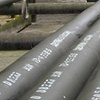

Hunan Standard Steel Co.,Ltd es uno de los miembros de Husteel Industry Group, como fabricante profesional de tuberías y accesorios de tubería de acero dulce, que tiene un sistema completo de producción ... Más
Fábrica GrupoApplication of Normalizing
fecha:2016-04-26
Vista:2621
After normalizing the intensity, hardness and toughness after annealing than high, ductility is not reduced. Application of normalizing and annealing normalizing similar, it has the following characteristics: high mechanical properties normalized steel, simple operation, short production cycle and less energy-consuming, so choose normalizing as possible. There are normalizing in the following aspects:
1. The general structure of the final heat treatment member; normalizing can eliminate casting or forging production overheating defects refine the organization, to improve the mechanical properties.
2. To improve the low carbon steel and low carbon alloy steel machinability; hardness 160 ~ 230HB metal cutting machining, high hardness of the metal, not only difficult to process, and tool wear, energy consumption is also large, low hardness, processing and easily stick the knife, the tool heat and wear, and surface finish of machined parts is very poor. Shading indicates better cutting performance and low-carbon steel annealing 160HB hardness generally in the following, and poor machinability, but the choice of normalizing (1:00 dash line), since the increase in the amount of pearlite, the lamellar spacing becomes thin, so that improved cutting performance.
3. As a medium carbon steel production than the main part of the pre-heat treatment; normalizing used to pre-heat treatment for the more important part. For example, carbon structural steel normalizing, make some abnormal tissue to normal tissue, eliminate thermal processing defects caused by the organization, and it is reduced to improve the quenching deformation and cracking quenching quality has a positive effect.
4. Elimination of eutectoid steel mesh in the secondary cementite for organizations to prepare for the ball annealing, normalizing This it is because the cooling rate is relatively fast, too late to reticulate secondary cementite precipitation along the grain boundaries A.
5. Some large or complex shaped parts, quenching may be at risk of cracking, often instead of normalizing quenching and tempering treatment, as these parts of the final heat treatment.
1. The general structure of the final heat treatment member; normalizing can eliminate casting or forging production overheating defects refine the organization, to improve the mechanical properties.
2. To improve the low carbon steel and low carbon alloy steel machinability; hardness 160 ~ 230HB metal cutting machining, high hardness of the metal, not only difficult to process, and tool wear, energy consumption is also large, low hardness, processing and easily stick the knife, the tool heat and wear, and surface finish of machined parts is very poor. Shading indicates better cutting performance and low-carbon steel annealing 160HB hardness generally in the following, and poor machinability, but the choice of normalizing (1:00 dash line), since the increase in the amount of pearlite, the lamellar spacing becomes thin, so that improved cutting performance.
3. As a medium carbon steel production than the main part of the pre-heat treatment; normalizing used to pre-heat treatment for the more important part. For example, carbon structural steel normalizing, make some abnormal tissue to normal tissue, eliminate thermal processing defects caused by the organization, and it is reduced to improve the quenching deformation and cracking quenching quality has a positive effect.
4. Elimination of eutectoid steel mesh in the secondary cementite for organizations to prepare for the ball annealing, normalizing This it is because the cooling rate is relatively fast, too late to reticulate secondary cementite precipitation along the grain boundaries A.
5. Some large or complex shaped parts, quenching may be at risk of cracking, often instead of normalizing quenching and tempering treatment, as these parts of the final heat treatment.
- Anterior : Surface Treatment of Pilling Pipe
- próximo : Preheating Deformation Demands of LSAW Steel Pipe
























